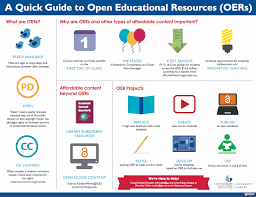
The Power of Open Educational Resources
Open Educational Resources (OER) have revolutionized the way we access and share educational materials. OER are freely accessible, openly licensed resources that can be used for teaching, learning, research, and other purposes.
One of the key benefits of OER is their accessibility. By removing cost barriers, OER make education more affordable and inclusive. Students from all backgrounds can access high-quality learning materials without having to worry about the financial burden of purchasing textbooks or other resources.
Furthermore, OER promote collaboration and knowledge sharing. Educators and learners can adapt and customize OER to suit their specific needs, creating a more personalized learning experience. This flexibility allows for innovation in teaching methods and curriculum development.
Another advantage of OER is their potential to reach a global audience. With the internet as a distribution platform, OER can be accessed by learners around the world, breaking down geographical boundaries and providing educational opportunities to those who may not have had access otherwise.
In conclusion, Open Educational Resources have transformed education by promoting accessibility, collaboration, customization, and global reach. As the OER movement continues to grow, we can expect to see even greater advancements in how knowledge is shared and disseminated in the digital age.
Frequently Asked Questions About Open Educational Resources: Access, Use, and Benefits
- What are Open Educational Resources (OER)?
- How can I access Open Educational Resources?
- Are Open Educational Resources free to use?
- Can I modify and customize Open Educational Resources for my needs?
- What are the benefits of using Open Educational Resources?
What are Open Educational Resources (OER)?
Open Educational Resources (OER) are educational materials that are freely available for use, sharing, and adaptation. These resources can include textbooks, lecture notes, videos, quizzes, and more, all of which are openly licensed to allow for easy access and modification. OER play a crucial role in promoting equitable access to education by eliminating cost barriers and fostering collaboration among educators and learners worldwide. By harnessing the power of OER, individuals can engage with high-quality educational content that can be tailored to meet their specific learning needs and preferences.
How can I access Open Educational Resources?
To access Open Educational Resources (OER), you can start by visiting dedicated websites and platforms that host a wide range of freely available educational materials. These platforms often allow you to search for specific topics, subjects, or types of resources to find what you need. Additionally, many educational institutions and organizations provide access to OER through their websites or online repositories. By exploring these resources, you can discover a wealth of materials that can enhance your learning experience without any cost barriers.
Are Open Educational Resources free to use?
Open Educational Resources (OER) are indeed free to use. One of the defining characteristics of OER is that they are openly licensed, allowing users to access, adapt, and share the materials without cost. This accessibility is a key feature of OER, as it enables educators and learners to benefit from high-quality educational resources without financial barriers. By leveraging OER, individuals can explore a wide range of materials for teaching, learning, and research purposes at no expense, promoting a more inclusive and equitable education system for all.
Can I modify and customize Open Educational Resources for my needs?
Yes, one of the key advantages of Open Educational Resources (OER) is the ability to modify and customize them to suit your specific needs. OER are openly licensed resources that give users the freedom to adapt the content, structure, and format to better align with their learning objectives or teaching methods. This flexibility allows educators and learners to tailor OER to their unique requirements, creating a more personalized and effective educational experience. By encouraging customization, OER promote innovation in curriculum development and teaching practices, empowering users to create engaging and relevant learning materials that meet their individual needs.
What are the benefits of using Open Educational Resources?
Open Educational Resources offer a myriad of benefits to educators, students, and institutions alike. One key advantage is the cost savings associated with OER, as they provide free access to high-quality educational materials, reducing financial barriers for learners. Additionally, OER promote collaboration and customization, allowing educators to adapt resources to meet specific learning objectives and student needs. Furthermore, the global accessibility of OER enables a wider reach of educational content, fostering inclusivity and expanding learning opportunities for individuals around the world. Overall, the benefits of using Open Educational Resources include affordability, flexibility, innovation in teaching methods, and increased access to education on a global scale.
